
Dermestidae are a family of Coleoptera that are commonly referred to as skin beetles. Other common names include larder beetle, hide or leather beetles, carpet beetles, and khapra beetles. There are over 1,100 species described.
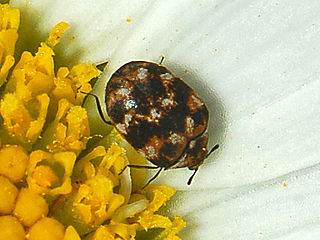
The varied carpet beetle is a 3 mm-long beetle belonging to the family Dermestidae. They are a common species, often considered a pest of domestic houses and, particularly, natural history museums, where the larvae may damage natural fibers and can damage carpets, furniture, clothing, and insect collections. A. verbasci was also the first insect to be shown to have an annual behavioral rhythm and to date remains a classic example of circannual cycles in animals.

Manduca quinquemaculata, the five-spotted hawkmoth, is a brown and gray hawk moth of the family Sphingidae. The caterpillar, often referred to as the tomato hornworm, can be a major pest in gardens; they get their name from a dark projection on their posterior end and their use of tomatoes as host plants. Tomato hornworms are closely related to the tobacco hornworm Manduca sexta. This confusion arises because caterpillars of both species have similar morphologies and feed on the foliage of various plants from the family Solanaceae, so either species can be found on tobacco or tomato leaves. Because of this, the plant on which the caterpillar is found does not indicate its species.
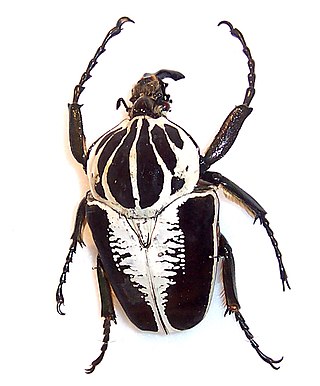
The Goliath beetles are any of the five species in the genus Goliathus. Goliath beetles are among the largest insects on Earth, if measured in terms of size, bulk and weight. They are members of subfamily Cetoniinae, within the family Scarabaeidae. Goliath beetles can be found in many of Africa's tropical forests, where they feed primarily on tree sap and fruit. Little appears to be known of the larval cycle in the wild, but in captivity, Goliathus beetles have been successfully reared from egg to adult using protein-rich foods such as commercial cat and dog food. Goliath beetles measure from 60–110 millimetres (2.4–4.3 in) for males and 50–80 millimetres (2.0–3.1 in) for females, as adults, and can reach weights of up to 80–100 grams (2.8–3.5 oz) in the larval stage, though the adults are only about half this weight. The females range from a dark chestnut brown to silky white, but the males are normally brown/white/black or black/white.
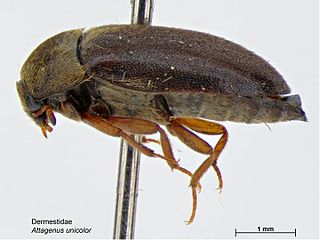
The black carpet beetle is a 3–5-millimetre-long (0.12–0.20 in) beetle that can be a serious household pest. The larvae grow to 7 mm (0.28 in) in length, are reddish brown in colour and covered with bristles. The larval form feeds on natural fibres, damaging carpets, furniture and clothing.

Cleridae are a family of beetles of the superfamily Cleroidea. They are commonly known as checkered beetles. The family Cleridae has a worldwide distribution, and a variety of habitats and feeding preferences.

Dermestes maculatus is a species of beetle with a worldwide distribution, being present on all continents except Antarctica. In Europe, it is present in all countries.
Home-stored product entomology is the study of insects which infest foodstuffs stored in the home. It deals with the prevention, detection and eradication of the pests. The five major categories of insects considered in this article are flour beetles, the drugstore beetle, the sawtoothed grain beetle, the Indianmeal moth and fruit flies.
Progressive provisioning is a term used in entomology to refer to a form of parental behavior in which an adult feeds its larvae directly after they have hatched, feeding each larva repeatedly until it has completed development. The food is typically in the form of masticated or immobilized prey items, or regurgitated nectar mixed with pollen ; only rarely are other sorts of food resources used. While this sort of direct and repetitive feeding of offspring is extremely common in groups such as birds and mammals, it is far less common among insects, with the exception of eusocial insects. Accordingly, progressive provisioning is universal among ants, and widespread among the social bees and wasps. Certain nonsocial wasps also rear their young with this type of feeding. Young termites are able to feed themselves, and therefore do not demonstrate any form of provisioning.
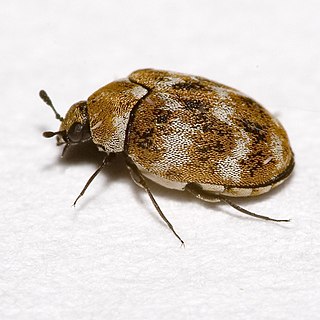
Anthrenus is a genus of beetles in the family Dermestidae, the skin beetles. One of several genera of carpet beetles, Anthrenus was historically placed in a subfamily Anthreninae, though presently included in the Megatominae. The genus Neoanthrenus is closely related.

Hofmannophila is a genus of moths in the concealer moth family Oecophoridae. It is monotypic, with the single species Hofmannophila pseudospretella, the brown house moth, which appears to be closely related to species of the genus Borkhausenia.

Anthrenus museorum, commonly known as the museum beetle, is a species of beetle found in the Palearctic, the Near East and the Nearctic. In its larval form it damages all forms of dry skin and hair. The larva will also eat dry cheese, flour or cocoa occasionally. It is considered a pest, as it damages, among others, the skin of taxidermied animals, such as polar bears and big cats in museums.

Coleomegilla maculata, commonly known as the spotted lady beetle, pink spotted lady beetle or twelve-spotted lady beetle, is a large coccinellid beetle native to North America. The adults and larvae feed primarily on aphids and the species has been used as a biological control agent. Based on name connotation and to avoid confusion with other species also called "spotted ladybeetle", spotted pink ladybeetle is probably the most appropriate common name for this species.

Alaus oculatus, commonly called the eastern eyed click beetle or eyed elater, is a species of click beetle.

Anthrenocerus australis is a species of beetle belonging to the Dermestidae family. It is commonly known as the Australian carpet beetle and is one of the most researched of the thirty-one species in the Anthrenocerus genus. This is generally attributed to its prevalence throughout Australia and New Zealand and the negative economic and agricultural impact it has as a pest. It is the larvae that causes damage to products, not the adult beetle. The total life cycle of this insect is around three years, most of which is spent as a larva. Once the beetle reaches maturity, it only lives for between two and six weeks.
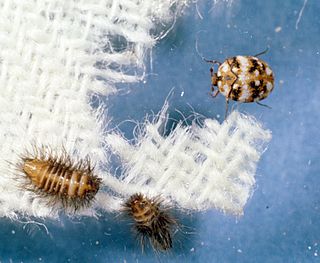
Anthrenus flavipes is a species of beetle in the family Dermestidae known by the common name furniture carpet beetle. It has a cosmopolitan distribution, occurring throughout the world, being most active in warmer climates. It is a pest that damages household materials such as textiles.
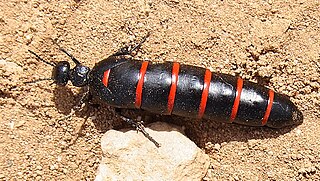
Berberomeloe majalis, the red-striped oil beetle, is an insect in the genus Berberomeloe, in the family of Blister Beetles. It is native to the western Mediterranean Basin.

Dermestes ater is a species of beetle in the family Dermestidae, the skin beetles. It is known commonly as the black larder beetle or incinerator beetle. It is native to North America, but today it is found nearly worldwide. Like several other dermestid beetles, this species is a common pest of stored products.
Anthrenus sarnicus, the Guernsey carpet beetle, is a type of carpet beetle. It can be generally found in Great Britain. Its suborder is Polyphaga, the infraorder is Bostrichiformia, the superfamily is Bostrichoidea, and the family is Dermestidae. The carpet beetle is shaped like an oval and about the size of a pin.

The lemon tree borer, also known as the whistling beetle or the singing beetle, is a longhorn beetle endemic to New Zealand. Its larvae are generalist feeders, boring into the wood of a wide variety of trees, native and introduced. When citrus orchards were first established in New Zealand, this beetle started inflicting serious damage, and so gained the name "lemon tree borer". Four species within the genus Oemona have been identified, suggesting that more species could be found. When disturbed by predators or humans, the adult beetle stridulates creating a "rasp" or "squeak" sound by rubbing its thorax and head together against an area of thin ridges. Māori would eat a liquid called "pia manuka", which was produced by manuka trees when its wood was damaged by the larvae. When Captain Cook first arrived in NZ, his naturalists, Banks and Solander, collected a lemon tree borer in their first collection between 1769 and 1771. This oldest collected specimen can be found in the British Museum. A few years after the first collection, the species would be first described by the Danish naturalist Fabricius in 1775.



















